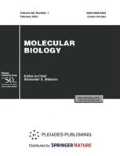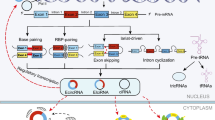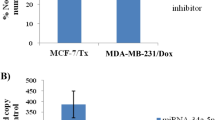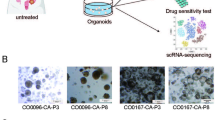Abstract
Using real-time RT-PCR in combination with bioinformatics, we have shown for the first time that the treatment of HCT-116 and HT-29 colon cancer cells with two anti-cancer agents (doxycycline or 3,3′-diindolylmethane) results in profound changes in the intracellular content of several lncRNAs (by up to 100 times). Since many of these RNAs are secreted by tumors into the bloodstream, the obtained results provide a basis for developing more sensitive protocols for serological monitoring of tumor relapse and metastasis, as well as for search of new anti-cancer drugs.
Similar content being viewed by others
Abbreviations
- lncRNA:
-
long noncoding RNA
- RNA-Seq:
-
a protocol for shotgun sequencing of cellular transcriptome
- qRT-PCR:
-
reverse transcription of RNA followed by qPCR
References
Pastori C., Kapranov P., Penas C., et al. 2015. The bromodomain protein BRD4 controls HOTAIR, a long noncoding RNA essential for glioblastoma proliferation. Proc. Natl. Acad. Sci. U. S. A. 112, 8326–8331.
Tani H., Torimura M. 2013. Identification of shortlived long non-coding RNAs as surrogate indicators for chemical stress response. Biochem. Biophys. Res. Commun. 439, 547–551.
Leem S.H., Li X.J., Park M.H., et al. 2015. Genomewide transcriptome analysis reveals inactivation of Wnt/beta-catenin by 3,3′-diindolylmethane inhibiting proliferation of colon cancer cells. Int. J. Oncol. 47, 918–926.
Lamb R., Fiorillo M., Chadwick A., et al. 2015. Doxycycline down-regulates DNA-PK and radiosensitizes tumor initiating cells: Implications for more effective radiation therapy. Oncotarget. 6, 14005–14025.
Semov A., Iourtchenco L., Liu L.F., et al. 2012. Diindolilmethane (DIM) selectively inhibits cancer stem cells. Biochem. Biophys. Res. Commun. 424, 45–51.
Qin Y., Zhang Q., Lee S., et al. 2015. Doxycycline reverses epithelial-to-mesenchymal transition and suppresses the proliferation and metastasis of lung cancer cells. Oncotarget. 6, 40667–40679.
Semov A., Iourtchenco L., Liu L.F., Li S., Xu Y., Su X., Muyjnek E., Kiselev V., Alakhov V. 2012. Diindolilmethane (DIM) selectively inhibits cancer stem cells. Biochem. Biophys. Res. Commun. 424, 45–51.
Lerner A., Grafi-Cohen M., Napso T., et al. 2012. The indolic diet-derivative, 3,3′-diindolylmethane, induced apoptosis in human colon cancer cells through upregulation of NDRG1. J. Biomed. Biotechnol. 2012, 256178.
Lukkonen A., Sorsa T., Salo T., et al. 2000. Down-regulation of trypsinogen-2 expression by chemically modified tetracyclines: Association with reduced cancer cell migration. Int. J. Cancer. 15, 577–581.
Livak K.J., Schmittgen T.D. 2001. Analysis of relative gene expression data using real-time quantitative PCR and the 2(-Delta Delta C(T)) method. Methods. 25, 402–408.
Vandesompele J., De Preter K., Pattyn F., et al. 2002. Accurate normalization of real-time quantitative RTPCR data by geometric averaging of multiple internal control genes. Genome Biol. 3, research0034.1–research0034.11.
Kim S.K., Kim S.Y., Kim J.H., et al. 2014. A nineteen gene-based risk score classifier predicts prognosis of colorectal cancer patients. Mol. Oncol. 8, 1653–1666.
Xiang J.F., Yin Q.F., Chen T., et al. 2014. Human colorectal cancer-specific CCAT1-L lncRNA regulates long-range chromatin interactions at the MYC locus. Cell Res. 24, 513–531.
Zhou K.R., Liu S., Sun W.J., et al. 2017. ChIPBase v2.0: Decoding transcriptional regulatory networks of non-coding RNAs and protein-coding genes from ChIP-seq data. Nucleic Acids Res. 45 (D1), D43–D50.
Guttman M., Garber M., Levin J.Z., et al. 2010. Ab initio reconstruction of cell type-specific transcriptomes in mouse reveals the conserved multi-exonic structure of lincRNAs. Nat. Biotechnol. 28, 503–510.
Shan T.D., Xu J.H., Yu T., et al. 2016. Knockdown of linc-POU3F3 suppresses the proliferation, apoptosis, and migration resistance of colorectal cancer. Oncotarget. 7, 961–975.
Sun J., Ding C., Yang Z., et al. 2016. The long noncoding RNA TUG1 indicates a poor prognosis for colorectal cancer and promotes metastasis by affecting epithelial-mesenchymal transition. J. Transl. Med. 14, 42.
Xing Z., Lin A., Li C., et al. 2014. lncRNA directs cooperative epigenetic regulation downstream of chemokine signals. Cell. 159, 1110–1125.
Ioannidis J.P. 2005. Why most published research findings are false. PLoS Med. 2, e124.
Voorneveld P.W., Kodach L.L., Jacobs R.J., et al. 2015. The BMP pathway either enhances or inhibits the Wnt pathway depending on the SMAD4 and p53 status in CRC. Br. J. Cancer. 112, 122–130.
Lian W.J., Liu G., Liu Y.J., et al. 2013. Downregulation of BMP6 enhances cell proliferation and chemoresistance via activation of the ERK signaling pathway in breast cancer. Oncol. Rep. 30, 193–200.
Tong Y.S., Wang X.W., Zhou X.L., et al. 2015. Identification of the long non-coding RNA POU3F3 in plasma as a novel biomarker for diagnosis of esophageal squamous cell carcinoma. Mol. Cancer. 14, 3.
Zhao W., Song M., Zhang J., et al. 2015. Combined identification of long non-coding RNA CCAT1 and HOTAIR in serum as an effective screening for colorectal carcinoma. Int. J. Clin. Exp. Pathol. 8, 14131–14140.
Dong L., Lin W., Qi P., et al. 2016. Circulating long RNAs in serum extracellular vesicles: Their characterization and potential application as biomarkers for diagnosis of colorectal cancer. Cancer Epidemiol. Biomarkers Prev. 25, 1158–1166.
Author information
Authors and Affiliations
Corresponding author
Additional information
Original Russian Text © O.L. Zinovieva, E.N. Grineva, M.M. Prokofjeva, D.S. Karpov, G.S. Krasnov, V.S. Prassolov, T.D. Mashkova, N.A. Lisitsyn, 2017, published in Molekulyarnaya Biologiya, 2017, Vol. 51, No. 5, pp. 841–848.
The article was translated by the author.
Rights and permissions
About this article
Cite this article
Zinovieva, O.L., Grineva, E.N., Prokofjeva, M.M. et al. Treatment with anti-cancer agents results in profound changes in lncRNA expression in colon cancer cells. Mol Biol 51, 733–739 (2017). https://doi.org/10.1134/S0026893317050247
Received:
Accepted:
Published:
Issue Date:
DOI: https://doi.org/10.1134/S0026893317050247




